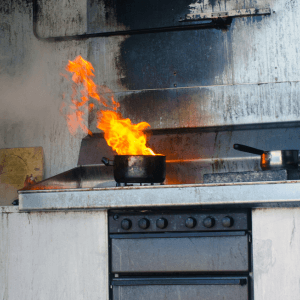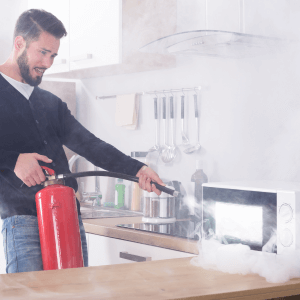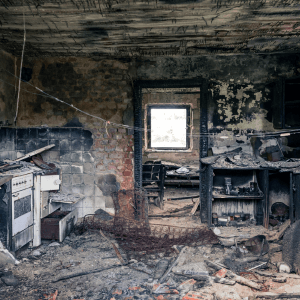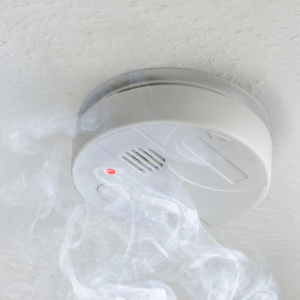Cooking caused an average of 158,400 reported home structure fires per year, resulting in 470 civilian deaths and 4,150 injuries annually. These stark numbers serve as a sobering reminder of the hidden dangers lurking in our kitchens. While cooking is part of our daily routines, the high temperatures involved can easily ignite a fire, turning a simple meal preparation into a potential disaster. Just because you’ve never had a fire doesn’t mean you never will. This is why prioritizing fire safety in the kitchen is crucial. Understanding the risks and taking preventive measures can protect you, your loved ones, and your home from the devastating effects of kitchen fires. Let’s delve into essential safety tips and awareness strategies that can help keep your kitchen—and your household—safe from harm.
What is a Kitchen Fire?
We’ve all been there. You’re cooking dinner, maybe making your favorite grilled cheese sandwich. You get distracted by a phone call or a child, and before you know it, the pan on the stove is smoking. The butter has caught fire, and the flames are starting to lick up the sides of the pan.
That’s a kitchen fire. It can be as small as a single flame on a pan or as large as a fire that engulfs the entire kitchen. Even a small fire can quickly spread and become dangerous if not addressed promptly.
Remember, any fire in the kitchen is a potential hazard. Always be mindful of what’s happening on the stove, and have a fire extinguisher readily available in case of an emergency. To prevent kitchen fires, it’s important to understand the common causes.
Main Causes of Kitchen Fires

Cooking is a fundamental part of our daily lives, but it can also be a dangerous activity if not done with caution. The high temperatures involved in cooking can easily lead to fires if proper safety measures are not followed. According to recent statistics, cooking was the leading cause of reported home fires and injuries in the United States between 2017 and 2021.
Let’s take a closer look at some of the most common causes of kitchen fires:
Unattended Cooking
This is the most frequent cause of kitchen fires. It’s easy to get distracted by phone calls, children, or other tasks, but even a brief moment away can be enough for a fire to start. Always stay in the kitchen and keep a close eye on your food, especially when cooking with high heat.
Overheating Oil
Cooking with oil can be dangerous if the oil gets too hot. When oil reaches its smoking point, it can ignite. To prevent this, avoid overcrowding the pan, and use a thermometer to monitor the oil temperature.
Grease Buildup
Grease buildup in your stovetop, oven, or hood can be a fire hazard. Regularly clean your kitchen appliances to remove any grease or food residue.
Electrical Faults
Faulty wiring or damaged electrical cords can cause fires. Inspect your kitchen appliances regularly and replace any damaged cords or outlets.
Flammable Materials Near Heat Sources
Keep flammable materials like paper towels, curtains, or potholders away from heat sources. These items can easily catch fire if they come into contact with a hot stove or oven.
Less Common Causes
While the above are the most common causes, there are also less frequent scenarios that can lead to kitchen fires:
- Spills and Splatters: Food spills and splatters can ignite if they come into contact with a hot stove or burner.
- Open Flames: Using open flames, such as those from a gas stove or a candle, can increase the risk of fire.
- Children and Pets: Children and pets can accidentally start fires by playing with matches, lighters, or pots and pans.
Best Methods to Extinguish Kitchen Fires

- Different Types of Kitchen Fires
Not all fires are created equal. You’ve got your grease fires, electrical fires, and more. Each requires a unique approach to extinguish safely. Knowing the type of fire you’re dealing with is the first step in putting it out effectively.
- Using a Fire Extinguisher
Every Austin kitchen should have a fire extinguisher handy. But do you know how to use it? Aim the nozzle at the base of the fire and sweep side to side. Remember, there are different types of extinguishers for various fires—make sure you’re equipped with the right one. Learn how to use a fire extinguisher properly here.
- Smothering Flames with a Lid or Baking Soda
If it’s a small kitchen fire, like a grease fire, you can often smother it. Use a metal lid to cover the flames or sprinkle baking soda to cut off the oxygen supply. Never use flour—it won’t work and might make things worse.
- When and How to Safely Use a Fire Blanket
For small cooking fires, a fire blanket can be lifesaving. Gently drape it over the flames to suffocate the fire. Ensure you approach cautiously to avoid burns and follow instructions for effective use.
What Not to Do During a Kitchen Fire
- Don’t Use Water on Grease Fires
Pouring water on a grease fire might seem instinctual, but it’s a big no-no. Water can cause the oil to splatter and spread the fire. Instead, use methods like smothering with a lid.
- Don’t Attempt to Move a Flaming Pan
Your first thought might be to move the pan to the sink, but don’t. Moving it can spread the fire or cause burns. Instead, turn off the heat and use a proper method to extinguish the flames.
- Don’t Use Fire Extinguisher Incorrectly
In the heat of the moment, it’s easy to panic. But remember to pull the pin, aim at the fire, squeeze the handle, and sweep side to side. Practicing beforehand can make you more prepared.
- Don’t Leave the Kitchen Unattended!
It sounds simple, but stepping away from the stove can lead to disaster. Stay attentive, and if you must leave, turn off the burner temporarily.
What to Do After a Kitchen Fire

- Ensuring the Fire is Completely Out and the Area is Safe
Once the fire is out, double-check that there are no remaining smoldering areas. Ventilate the space to clear out smoke damage, ensuring the safety of your family and home.
- Documenting Damage for Insurance Purposes
Take photos and notes of the damage for insurance claims. Documentation is key to getting the coverage you need to restore your kitchen.
Companies like All Nation Restoration in Round Rock offer expert services to repair fire damage and smoke damage efficiently. Professional help ensures your kitchen returns to its former glory quickly.
- Evaluating and Replacing Damaged Appliances or Kitchenware
Inspect all kitchen equipment and replace anything that’s been compromised. Safety comes first, and faulty appliances can pose future risks.
Read more from our blog: Cleaning Up Fire and Smoke
Cooking Fire Safety Tips
- Regular Maintenance and Cleaning of Kitchen Appliances
A clean kitchen is a safe kitchen. Routine maintenance checks prevent grease build-up and ensure appliances function correctly, minimizing fire risks.
- Installing and Knowing How to Use Smoke Alarms
Smoke alarms are your first line of defense. Install them in the kitchen and throughout your home. Test them monthly to ensure they’re working as they should.
- Safe Cooking Practices
Avoid wearing loose clothing while cooking. Keep flammable items away from the stovetop. Simple actions can prevent big problems.
- Keeping Flammable Items Away from Stovetops
Items like kitchen towels, paper towels, and curtains should be stored away from cooking areas. They can easily catch fire if placed too close to an open flame.
Kitchen Fire Statistics
All the stats listed are from the link above. Click to read more in detail.
Cooking is the leading cause of home fires, injuries, and deaths.
- Between 2017 and 2021, cooking was responsible for 44% of all reported home fires, 42% of home fire injuries, and 18% of home fire deaths.
- Unattended cooking is the primary factor contributing to these fires.
- Ranges and cooktops are involved in 53% of reported home cooking fires, 88% of cooking fire deaths, and 74% of cooking fire injuries
. - Households with electric ranges have a higher risk of cooking fires and associated losses compared to those with gas ranges.
The Dangers of Home Cooking Fires
- Overheating oil is a common cause of cooking fires.
- Grease buildup can pose a fire hazard if not cleaned regularly.
- Electrical faults and flammable materials near heat sources can also contribute to kitchen fires.
- More than half of non-fatal injuries occur when people attempt to control the fire themselves.
- Smoke alarms are crucial for early detection and can significantly reduce casualties.
Devastating Kitchen Fire Facts
- Unattended cooking is involved in 85% of cooking fire deaths and 75% of cooking fire injuries.
- More than one-quarter of the people killed by cooking fires were asleep when they were fatally injured.
- Clothing was the item first ignited in less than 1% of these fires, but clothing ignition led to 7% of the home cooking fire deaths.
- Ranges or cooktops were involved in 53% of the reported home cooking fires, 88% of cooking fire deaths, and 74% of cooking fire injuries.
- Households with electric ranges had a higher risk of cooking fires and associated losses than those with gas ranges.
- Smoke alarms were present at 88% of the reported home cooking fires and 76% of the cooking fire deaths.
Read more from our blog:
–Hidden Dangers of Candle Fires
–SafeGuard Your Thanksgiving from Turkey Fryer Fires
Frequently Asked Questions (FAQ)

- What Should I Do If My Fire Extinguisher Fails?
If your extinguisher isn’t working, evacuate immediately and call the fire department. Ensure everyone is safe and away from the danger.
- How Often Should Smoke Alarms Be Tested or Replaced?
Test smoke alarms monthly and replace their batteries at least once a year. If an alarm is over ten years old, replace it entirely.
- Can Small Kitchen Fires Be Handled Without Calling the Fire Department?
If you’re confident the fire is out and there’s no risk of it reigniting, you may handle it. However, safety should always come first, and calling professionals is wise if unsure.
- What Are the First Steps in Restoring My Kitchen After a Fire?
Secure the area, document damages, and contact restoration experts like us at All Nation Restoration. We’ll help you through the process smoothly.
Kitchen Fire Prevention- A Flame-Free Future
Kitchen fire awareness is more than just knowing how to put out a fire; it’s about prevention, preparation, and swift action. By adopting the preventive measures we’ve discussed, you can protect your loved ones and home from devastating kitchen fires. Remember, All Nation Restoration is here to assist with fire damage recovery and prevention planning in your Central Texas community. Stay safe, and happy cooking!







